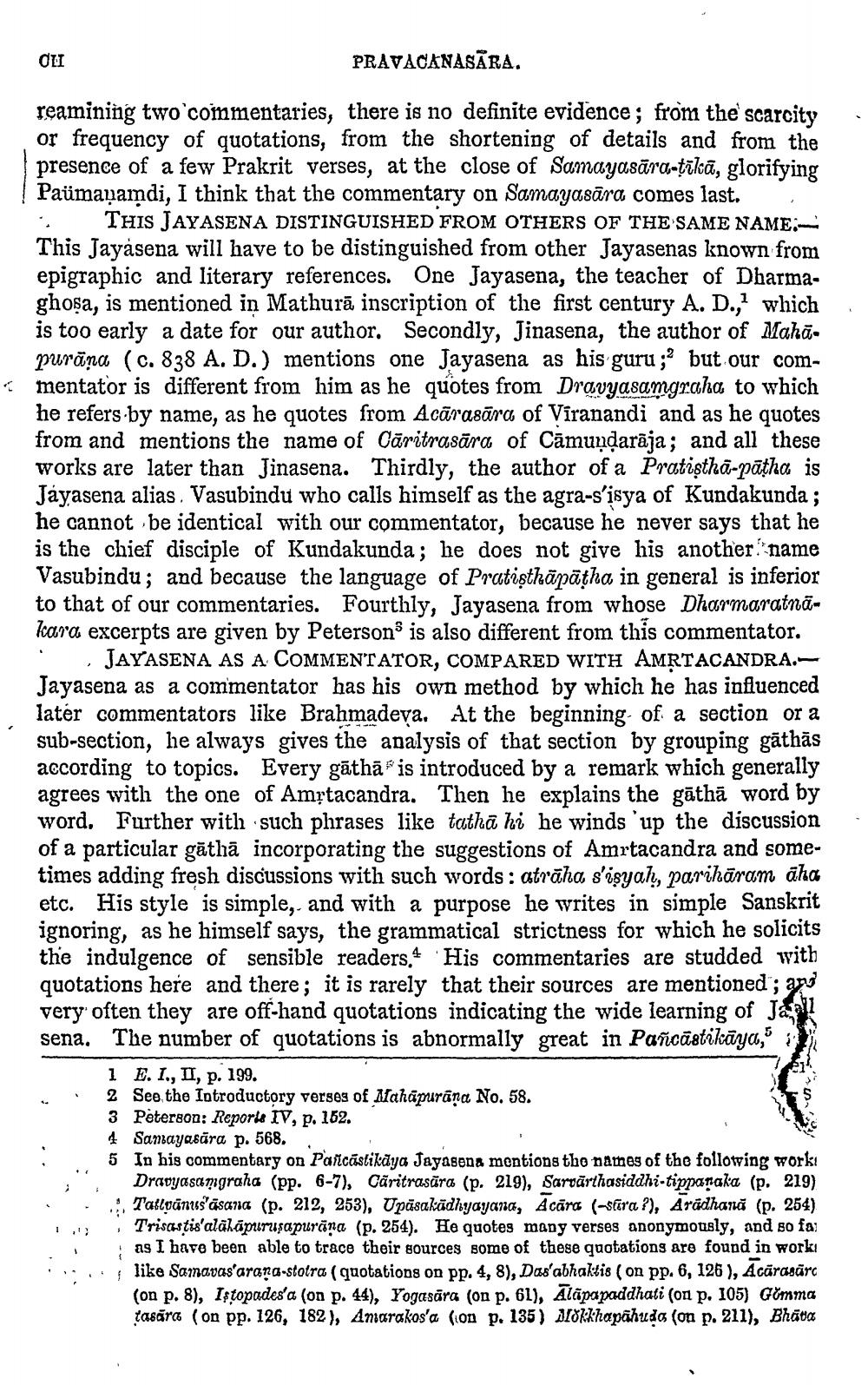________________
OLI
PRAVACANASÄRA.
reamining two commentaries, there is no definite evidence; from the scarcity or frequency of quotations, from the shortening of details and from the presence of a few Prakrit verses, at the close of Samayasāra-tīkā, glorifying Paümayamdi, I think that the commentary on Samayasāra comes last. . THIS JAYASENA DISTINGUISHED FROM OTHERS OF THE SAME NAME:This Jayasena will have to be distinguished from other Jayasenas known from epigraphic and literary references. One Jayasena, the teacher of Dharmaghosa, is mentioned in Mathurā inscription of the first century A. D., which is too early a date for our author. Secondly, Jinasena, the author of Mahāpuräna (C. 838 A. D.) mentions one Jayasena as his guru;? but our commentator is different from him as he quotes from Dravyasamgraha to which he refers by name, as he quotes from Acārasāra of Viranandi and as he quotes from and mentions the name of Cāritrasāra of Cāmundarāja; and all these works are later than Jinasena. Thirdly, the author of a Pratisthā-pātha is Jayasena alias. Vasubindu who calls himself as the agra-s'isya of Kundakunda; he cannot be identical with our commentator, because he never says that he is the chief disciple of Kundakunda; he does not give his another name Vasubindu; and because the language of Pratisthāpātha in general is inferior to that of our commentaries. Fourthly, Jayasena from whose Dharmaratnakara excerpts are given by Peterson is also different from this commentator.
JAYASENA AS A COMMENTATOR, COMPARED WITH AMRTACANDRA. Jayasena as a commentator has his own method by which he has influenced later commentators like Brahmadeva. At the beginning of a section or a sub-section, he always gives the analysis of that section by grouping gāthās according to topics. Every gāthā is introduced by a remark which generally agrees with the one of Amrtacandra. Then he explains the gāthā word by word. Further with such phrases like tatha hi he winds 'up the discussion of a particular gāthā incorporating the suggestions of Amrtacandra and sometimes adding fresh discussions with such words: atrāha s'isyah, parihāram āha etc. His style is simple, and with a purpose he writes in simple Sanskrit ignoring, as he himself says, the grammatical strictness for which he solicits the indulgence of sensible readers. His commentaries are studded with quotations here and there; it is rarely that their sources are mentioned ; ang very often they are off-hand quotations indicating the wide learning of Jail sena. The number of quotations is abnormally great in Pañcâstikāya,"
1 E.I., II, p. 199. 2 See the Introductory verses of Mahapurana No. 58. 3 Peterson: Reporis IV, p. 162. 4 Sanayasāra p. 568.. 5 In his commentary on Paicāstikaya Jayasena mentions the names of the following work!
Dradyasangraha (pp. 6-7), Căritrasāra (p. 219), Sarcárthasiddhi-tippanaka (p. 219) ... Tattoānus'āsana (p. 212, 253), Upasakādhyayana, Acāra (asfira ?), Aradhana (p. 254)
Trisastis'alālāpuruşapurana (p. 254). He quotes many verses anonymously, and so faz ; as I have been able to trace their sources some of these quotations are found in work! į like Samavas'arana-stotra ( quotations on pp. 4, 8), Das'abhaktis (on pp. 6, 126 ), Acarasāro (on p. 8), Istopades'a (on p. 44), Yogasāra (on p. 61), Alūpapaddhati (on p. 105) Gömma tasara (on pp. 126, 182), Anarakos'a (on p. 135) Dokkhapāhudo (on p. 211), Bhado




